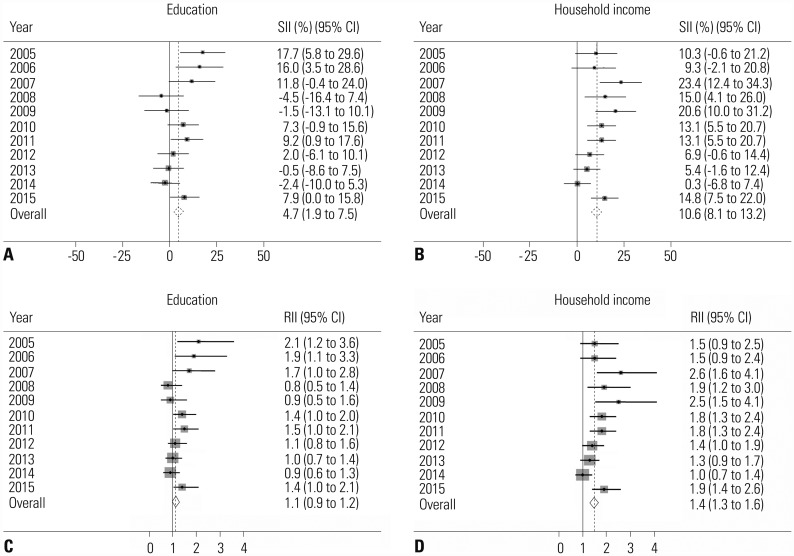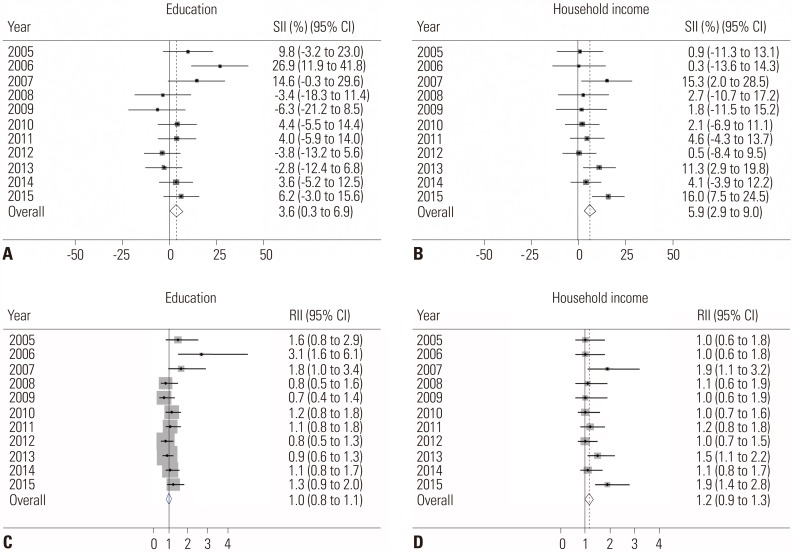Yonsei Med J.
2018 Nov;59(9):1026-1033. 10.3349/ymj.2018.59.9.1026.
Socioeconomic Inequalities in Cervical and Breast Cancer Screening among Women in Korea, 2005–2015
- Affiliations
-
- 1Graduate School of Cancer Science and Policy, National Cancer Center, Goyang, Korea. kschoi@ncc.re.kr
- 2National Cancer Control Institute, National Cancer Center, Goyang, Korea.
- KMID: 2422486
- DOI: http://doi.org/10.3349/ymj.2018.59.9.1026
Abstract
- PURPOSE
Consistent evidence indicates that cervical and breast cancer screening rates are low among socioeconomically deprived women. This study aimed to assess trends in cervical and breast cancer screening rates and to analyze socioeconomic inequalities among Korean women from 2005 to 2015.
MATERIALS AND METHODS
Data from the Korean National Cancer Screening Survey, an annual nationwide cross-sectional survey, were utilized. A total of 19910 women were finally included for analysis. Inequalities in education and household income status were estimated by slope index of inequality (SII) and relative index of inequality (RII), along with calculation of annual percent changes (APCs), to show trends in cancer screening rates.
RESULTS
Cervical and breast cancer screening rates increased from 54.8% in 2005 to 65.6% in 2015 and from 37.6% in 2005 to 61.2% in 2015, respectively. APCs in breast cancer screening rates were significant among women with higher levels of household income and education status. Inequalities by household income in cervical cancer screening uptake were observed with a pooled SII estimate of 10.6% (95% CI: 8.1 to 13.2) and RII of 1.4 (95% CI: 1.3 to 1.6). Income inequalities in breast cancer screening were shown to gradually increase over time with a pooled SII of 5.9% (95% CI: 2.9 to 9.0) and RII of 1.2 (95% CI: 0.9 to 1.3). Educational inequalities appeared to diminish over the study period for both cervical and breast cancer screening.
CONCLUSION
Our study identified significant inequalities among socioeconomically deprived women in cervical and breast cancer screening in Korea. Especially, income-related inequalities were greater than education-related inequalities, and these were constant from 2005 to 2015 for both cervical and breast cancer screening.
Keyword
MeSH Terms
Figure
Cited by 1 articles
-
Impact of the Learning Curve on the Survival of Abdominal or Minimally Invasive Radical Hysterectomy for Early-Stage Cervical Cancer
Lan Ying Li, Lan Ying Wen, Sun Hee Park, Eun Ji Nam, Jung Yun Lee, Sunghoon Kim, Young Tae Kim, Sang Wun Kim
Cancer Res Treat. 2021;53(1):243-251. doi: 10.4143/crt.2020.063.
Reference
-
1. Ferlay J, Soerjomataram I, Dikshit R, Eser S, Mathers C, Rebelo M, et al. Cancer incidence and mortality worldwide: sources, methods and major patterns in GLOBOCAN 2012. Int J Cancer. 2015; 136:E359–E386. PMID: 25220842.
Article2. Teng AM, Atkinson J, Disney G, Wilson N, Blakely T. Changing socioeconomic inequalities in cancer incidence and mortality: Cohort study with 54 million person-years follow-up 1981-2011. Int J Cancer. 2017; 140:1306–1316. PMID: 27925183.
Article3. Lundqvist A, Andersson E, Ahlberg I, Nilbert M, Gerdtham U. Socioeconomic inequalities in breast cancer incidence and mortality in Europe-a systematic review and meta-analysis. Eur J Public Health. 2016; 26:804–813. PMID: 27221607.
Article4. Palència L, Espelt A, Rodríguez-Sanz M, Puigpinós R, Pons-Vigués M, Pasarín MI, et al. Socio-economic inequalities in breast and cervical cancer screening practices in Europe: influence of the type of screening program. Int J Epidemiol. 2010; 39:757–765. PMID: 20176587.5. Wharam JF, Zhang F, Xu X, Landon BE, Ross-Degnan D. National trends and disparities in cervical cancer screening among commercially insured Women, 2001-2010. Cancer Epidemiol Biomarkers Prev. 2014; 23:2366–2373. PMID: 25128400.
Article6. Drolet M, Boily MC, Greenaway C, Deeks SL, Blanchette C, Laprise JF, et al. Sociodemographic inequalities in sexual activity and cervical cancer screening: implications for the success of human papillomavirus vaccination. Cancer Epidemiol Biomarkers Prev. 2013; 22:641–652. PMID: 23549400.
Article7. Miller JW, Plescia M, Ekwueme DU. Public health national approach to reducing breast and cervical cancer disparities. Cancer. 2014; 120(Suppl 16):2537–2539. PMID: 25099895.
Article8. Smith-Bindman R, Miglioretti DL, Lurie N, Abraham L, Barbash RB, Strzelczyk J, et al. Does utilization of screening mammography explain racial and ethnic differences in breast cancer? Ann Intern Med. 2006; 144:541–553. PMID: 16618951.
Article9. Jung KW, Won YJ, Oh CM, Kong HJ, Lee DH, Lee KH. Community of Population-Based Regional Cancer Registries. Cancer statistics in Korea: incidence, mortality, survival, and prevalence in 2014. Cancer Res Treat. 2017; 49:292–305. PMID: 28279062.
Article10. Choi E, Lee YY, Yoon HJ, Lee S, Suh M, Park B, et al. Relationship between cancer worry and stages of adoption for breast cancer screening among Korean women. PLoS One. 2015; 10:e0132351. PMID: 26186652.
Article11. Yoo KY. Cancer control activities in the Republic of Korea. Jpn J Clin Oncol. 2008; 38:327–333. PMID: 18407932.
Article12. Suh M, Choi KS, Park B, Lee YY, Jun JK, Lee DH, et al. Trends in cancer screening rates among Korean men and women: results of the Korean National Cancer Screening Survey, 2004-2013. Cancer Res Treat. 2016; 48:1–10. PMID: 25943324.
Article13. Kim S, Kwon S, Subramanian SV. Has the National Cancer Screening Program reduced income inequalities in screening attendance in South Korea? Cancer Causes Control. 2015; 26:1617–1625. PMID: 26335263.
Article14. Lee M, Park EC, Chang HS, Kwon JA, Yoo KB, Kim TH. Socioeconomic disparity in cervical cancer screening among Korean women: 1998-2010. BMC Public Health. 2013; 13:553. PMID: 23742100.
Article15. Park MJ, Park EC, Choi KS, Jun JK, Lee HY. Sociodemographic gradients in breast and cervical cancer screening in Korea: the Korean National Cancer Screening Survey (KNCSS) 2005-2009. BMC Cancer. 2011; 11:257. PMID: 21682886.
Article16. Renard F, Demarest S, Van Oyen H, Tafforeau J. Using multiple measures to assess changes in social inequalities for breast cancer screening. Eur J Public Health. 2014; 24:275–280. PMID: 23994840.
Article17. Lee JT, Huang Z, Basu S, Millett C. The inverse equity hypothesis: does it apply to coverage of cancer screening in middle-income countries? J Epidemiol Community Health. 2015; 69:149–155. PMID: 25311479.
Article18. Chiou ST, Wu CY, Hurng BS, Lu TH. Changes in the magnitude of social inequality in the uptake of cervical cancer screening in Taiwan, a country implementing a population-based organized screening program. Int J Equity Health. 2014; 13:4. PMID: 24405587.
Article19. OECD. Education at a Glance 2017: OECD Indicators. Paris: OECD Publishing;2017.
- Full Text Links
- Actions
-
Cited
- CITED
-
- Close
- Share
- Similar articles
-
- Socioeconomic Inequalities in Colorectal Cancer Screening in Korea, 2005–2015: After the Introduction of the National Cancer Screening Program
- Socioeconomic Inequalities in Stomach Cancer Screening in Korea, 2005–2015: After the Introduction of the National Cancer Screening Program
- Socioeconomic Disparities in Breast Cancer Screening among US Women: Trends from 2000 to 2005
- Trends in cervical cancer screening rates among Korean women: results of the Korean National Cancer Screening Survey, 2005–2020
- Socioeconomic inequalities in health status in Korea



